|
Audio Version
Getting your Trinity Audio player ready...
|
While plastic recycling may seem like one of the most important ecological actions, it is actually far from being efficient. Brands that argue otherwise are taking advantage of the word “recyclable” to create the buzz to improve their image and sell more of their stuff; in other words, they are usually practicing greenwashing.
Plastic has taken a huge space in our lives. It is everywhere and it is almost impossible to escape from it.
However, it is possible to live without it, as we can see through the zero waste movement.
Even though this citizens’ approach is strong, it remains an uncommon practice.
At Planeta Sana, we think we should start educating from the bottom up. Because let’s be honest, most of us can’t even recycle properly.
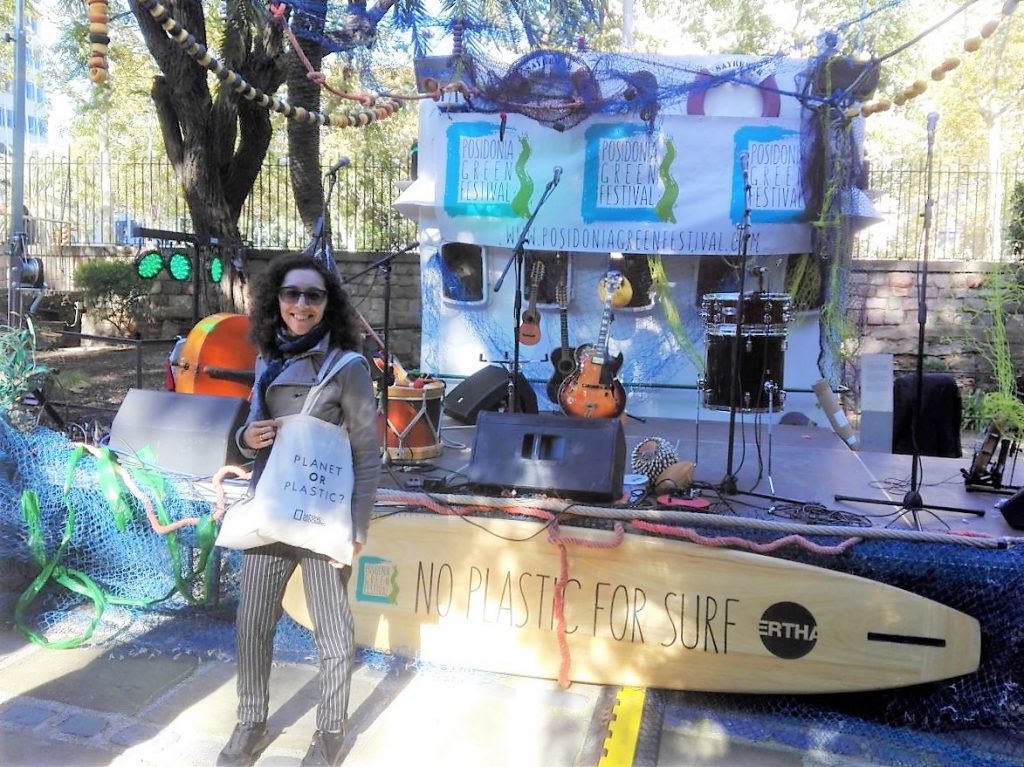

And it’s not because we don’t try.
Plastic recycling: Mission Impossible?
Often, manufacturers do not make it easy for us. They create materials that are difficult to recycle, or deceive us by trying to make us believe that their product is packaged in 100% recycled plastics, while they cannot factually prove that it is the case. But they use these kinds of arguments to give the illusion of some kind of environmental commitment.
Going back in history, the plastic used was initially only high density, durable, and it was in 1956 that a certain Lloyd Souffer encouraged the industry to make single-use plastic by saying during a conference for the Society of the Plastics Industry: The future of plastic is in the trash can.
The future of plastics is in the trash can. […] The happy day has arrived when nobody any longer considers the plastics package too good to throw away.
Lloyd Souffer
Hard to believe, isn’t it?
But actually, they had one goal: increase their margins.
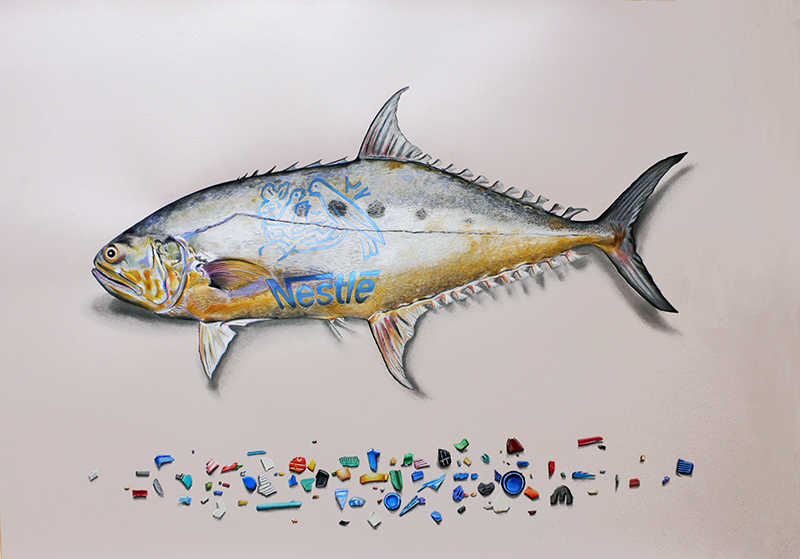

Another example that shows the industry’s bad faith: the green round logo with arrows. This does not mean that the product is recyclable. This simply means that the manufacturer of this packaging has paid a contribution for recycling in Europe.
In the United States, the logo in the shape of a triangle with arrows does not mean that the material is recyclable… In France and Spain it is the same, it simply means that the recycling of this plastic packaging depends on the community in which it will be deposited.
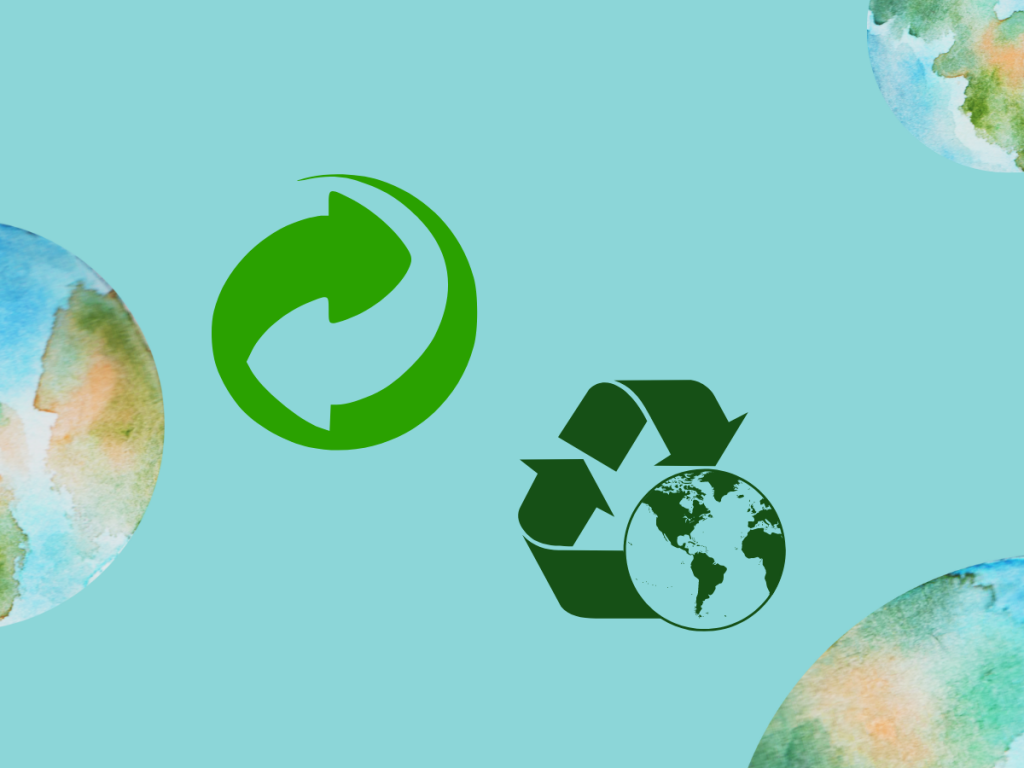

It’s time for us to take a closer look at the truths and falsehoods behind plastic recycling.
What is recycling?
First of all, we should define what the word recycling means. The true definition of recycling is using a material to turn it into an identical one. This is called closed loop recycling.
When the material is devalued, to make it into something of lesser quality, we speak of downcycling.
And when it is upgraded to make it a higher value product, it is called upcycling.
This is called open loop recycling.
And this is where plastic is problematic: it is rarely 100% recyclable because it loses its quality in the process of recycling and even when it is recycled, it is often in an open loop process.
Before recycling, you should know that every community is different.
Even within the same country, recycling is not the same from one city to another. This is why it is important to always check locally.
What type of plastic can we recycle?
Before recycling, you must know whether the piece of plastic is recyclable or not.
Types of plastics
Here is a glossary to better understand the different types of plastics that exist:
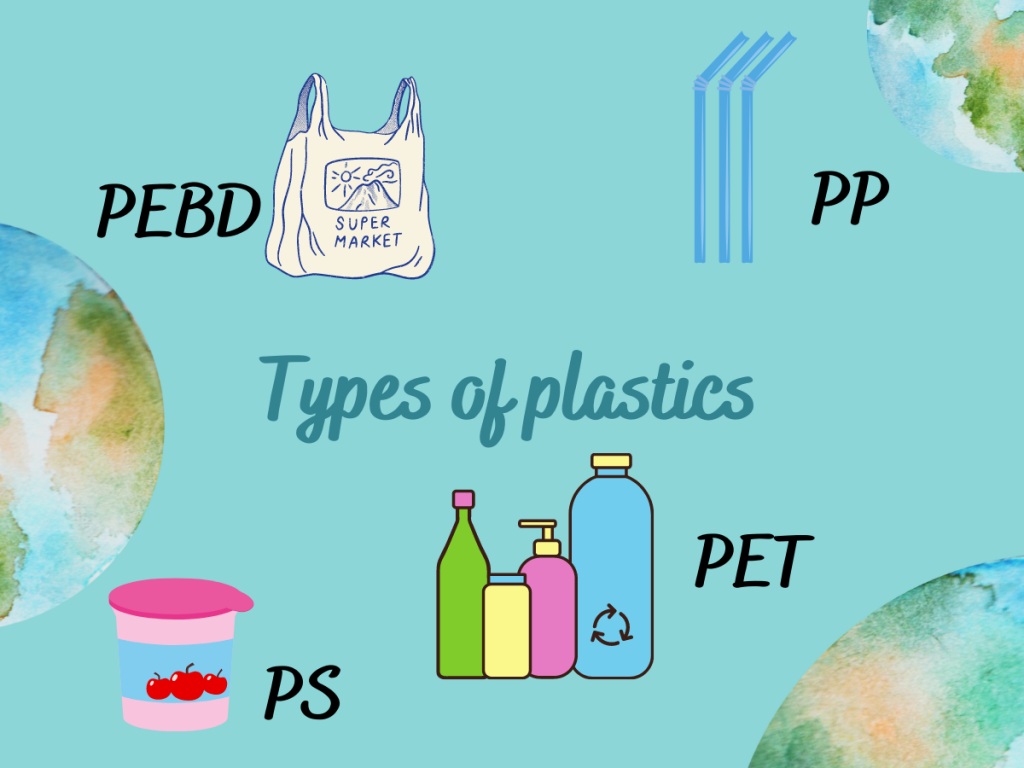

PP : Polypropylene
It is both a flexible and resistant material, used for many molded parts in the automotive sector (car parts), certain types of upholstery or disposable fabrics (eg: surgical masks), and food packaging (plastic trays from take-out meals, straws, etc.).
PS : Polystyrene
Used for packaging for the protection of devices, especially during transport, it is flammable and the ordinary form is non-degradable (lifespan of about 500 years buried). It is also found in the form of yoghurt pots.
PET : Polyethylene Terephtalate
This type of plastic is mainly used for bottles, flasks, jars. It is part of the thermoplastic family and is theoretically recyclable.
HDPE: High density polyethylene
It is a hard plastic, for example used for detergent and fabric softener bottles.
LDPE: Low density polyethylene
This type of plastic is soft and is used for plastic bags, films, and flexible containers.
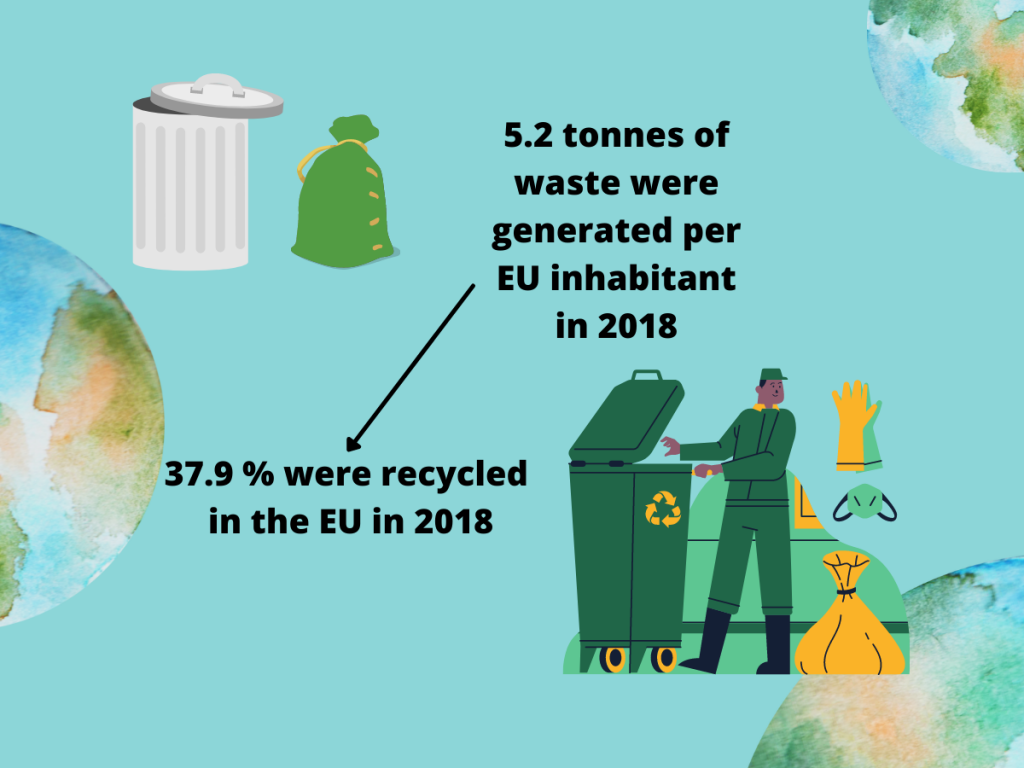

Study on the recyclability and recycling rate of these plastics
The Consumer Organization OCU in Spain carried out a study on 10 households that recycle their waste. They followed this waste to sorting sites and they were able to observe the rates at which these plastics were identified by the technology used in these Recycling facilities (optical sorters, magnets, or vacuums).
PET was recognized at a 27% rate, HDPE at 88%, PS at 12%, PP at 15% …
Other materials are much easier to detect, such as steel (100%) or aluminum (100%). This result is rather disappointing.
But that’s not all. Just because these products are identifiable does not mean they are recyclable.
The OCU therefore continued its study by making a comparison with the maximum recycling rate of these plastics or other materials, by checking with experts:
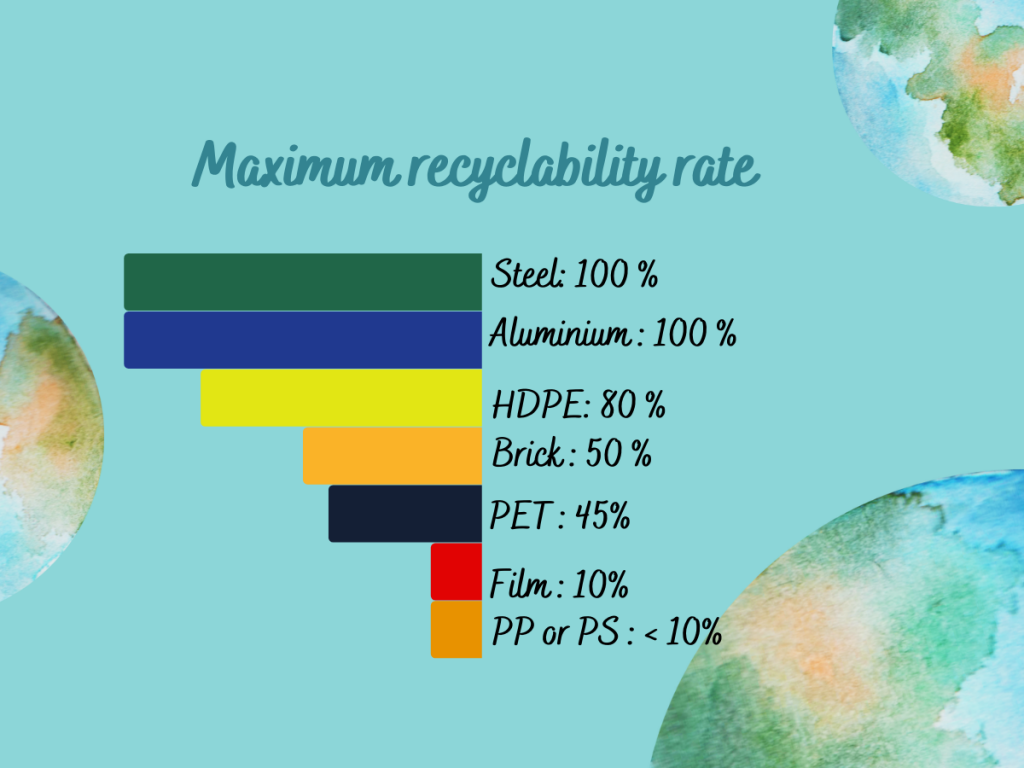

Indeed, steel and aluminum are very easy to recycle.
And this is good news, because it is very difficult to produce these materials and their manufacturing process is very polluting. But their recyclability rate allows it to be recycled indefinitely!
As for plastic, it all depends on the plastic in question. But apart from high density plastic, which recycles quite well, the rest is ridiculous… And even if some plastics can be recycled, it can be only once.
Why is plastic recycling difficult?
There seems to be 3 main reasons that make plastic recycling inefficient:
- A technically non performant recycling centre
- A lack of profitability to recycle a certain type of plastic
- Poor packaging design
There are therefore multiple barriers to recycling.
Some examples where plastic recycling is difficult, if not impossible:
- Labels can prevent machines that use optical systems from properly classifying the type of product and end up sending it to the wrong stream.
- Black colored packaging also makes the task of the optical system difficult because it appears invisible to them. The technology to sort this out exists, but it is not profitable.
- Opaque PET such as shampoo or milk bottles are not recycled because their color makes their subsequent recyclability rate very low.
- The intensely colored PET can be recycled, but not very profitably because the use would be limited to low quality products (textiles or automotive parts).
- Dimensions: small plastics (less than 5cm) are lost in the recycling circuit …
- The trays can be recycled but in a different circuit from that of PET bottles and there are very few recycling centers that can do this.
- Rigid packaging like bricks or toothpaste tubes are made of multiple layers that are difficult to separate. The same goes for flexible packaging such as packets of crisps or children’s drinks.
- The pump or pistol mechanisms of the bottles cause problems in the sorting center and are automatically discarded.
- PPs and PSs: recycling centres do not always have the correct line to be able to recycle those types of plastics. The technology exists but is not present in most countries, such as Spain.
Why recycling plastic?
Plastic is difficult to recycle. Does that mean that we should no longer put non-recyclable plastics in the yellow bin?
Recycle to improve waste management
The consumer organization OCU in Spain believes that we must continue to put difficult-to-recycle plastic in the yellow bin, because it forces recycling centers to see the problem and look for solutions.
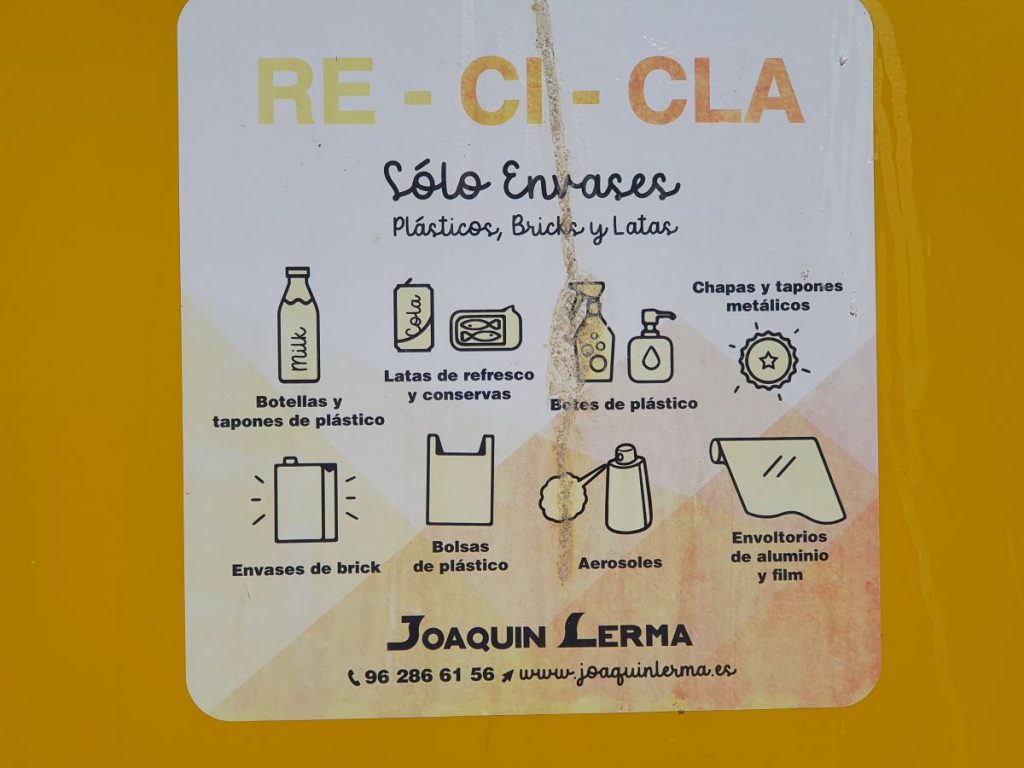

However, be careful with this kind of statement. It is not applicable everywhere…
In New York, for example, it’s a whole different story. They have what we call “Material Recovery Facility” or MRF.
Low-density plastic such as films are in fact harmful to MRFs.
MRFs do not recycle directly but resell the waste. This type of plastic often runs the risk of clogging processing machinery. That’s why it’s best not to recycle this kind of plastic in New York City (at least in 2021).
In addition, MRFs have to pay to get rid of this waste, which makes them lose money… These MRFs are important and we would not want them to go bankrupt…
That’s why it’s so important to check locally.
But anyway and in general, we can see that recycling plastic 100% is an illusion.
Recycle materials with a high recyclability rate
Other materials such as steel or aluminum are easily recognizable by MRFs machines and are 100% recyclable. PET plastic could also be recyclable at this rate, but the bottle must be clear or transparent light blue, and the machines must be able to remove the labels properly.
Note also that unlike steel and aluminum, plastic cannot be recycled endlessly. Normally it can be completely recycled (closed-loop) only once. Although there are a lot of different answers to this question in the industry.
This comment from the British Plastics Federation summarizes the complexity of the answer to the question “: How many times can you recycle plastic?”.
There is no simple answer to this. It depends on the type of plastic, how it is being recycled and what it is being recycled for. Polymers do slightly break down as they are recycled — but this minor degradation is easily countered by mixing in calculated amounts of ‘virgin’ (new) plastic.
Even if in June 2021, the sector claims to have found a way to recycle PET endlessly with an enzymatic recycling process, let’s remain cautious about such statements … And it would only concern one type of plastic anyway…
Recycle to reduce our emissions
Recycling is also important for the climate. Indeed, creating a new material has a significant carbon footprint. So logically, when we recycle, we use less greenhouse gases. While it is true that recycling also costs energy, the expense is small compared to the manufacturing process of a brand new material. The planet is lacking in raw materials. Whether it’s oil or gas for plastic, sand for glass, or bauxite for aluminum.
The problem with plastic is that we don’t know its real cost to the environment. Indeed, we only take into account the energy necessary for its manufacture. Plastic doesn’t take as much energy as other materials. Moreover, plastic recycling is complex, it can be expensive, and needs special recycling processes for each type of plastic. However, we do not calculate the harmful aspect of its degradation, that is to say the fine particles that it generates, such as microplastics or even plastic nanoparticles.
Recycle to encourage the circular economy
Another reason for recycling is to prevent plastic from ending up in nature.
The goal is to have a circular economy. Decycling, for example by creating clothes, is always better than doing nothing. On the other hand, we must be careful not to encourage the plastic industry using the circular economy as a pretext to continue business as usual, because that is another type of greenwashing… And as mentioned above, the degradation of plastic is still an issue when recycling, downcycling or upcycling it.
The danger of microplastics
When a piece of plastic ends up in nature, especially in the oceans, it breaks down very slowly but surely, ending up as microplastic. And plastic isn’t the main problem here, at least with our current scientific knowledge.
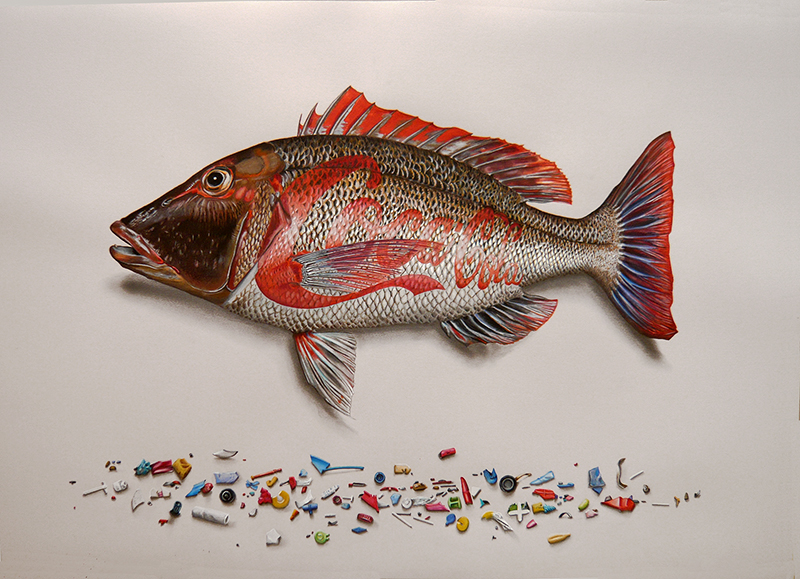

This kind of packaging contains chemical components.
It contains substances harmful to the planet and to our health such as endocrine disruptors like Bisphenol A, F and S, fluorinated compounds, phthalates, parabens, glycol ethers and flame retardants.
According to a survey by the Public Health authority in France (Santé Publique France), all French people, adults and children, are “impregnated” with these substances… The consequences can range from cancer, to precocious puberty, and include diabetes, obesity or even a reduction in fertility. A similar study with similar results has been conducted by the NCBI, that also mentions another element of concern: nanoplastics.
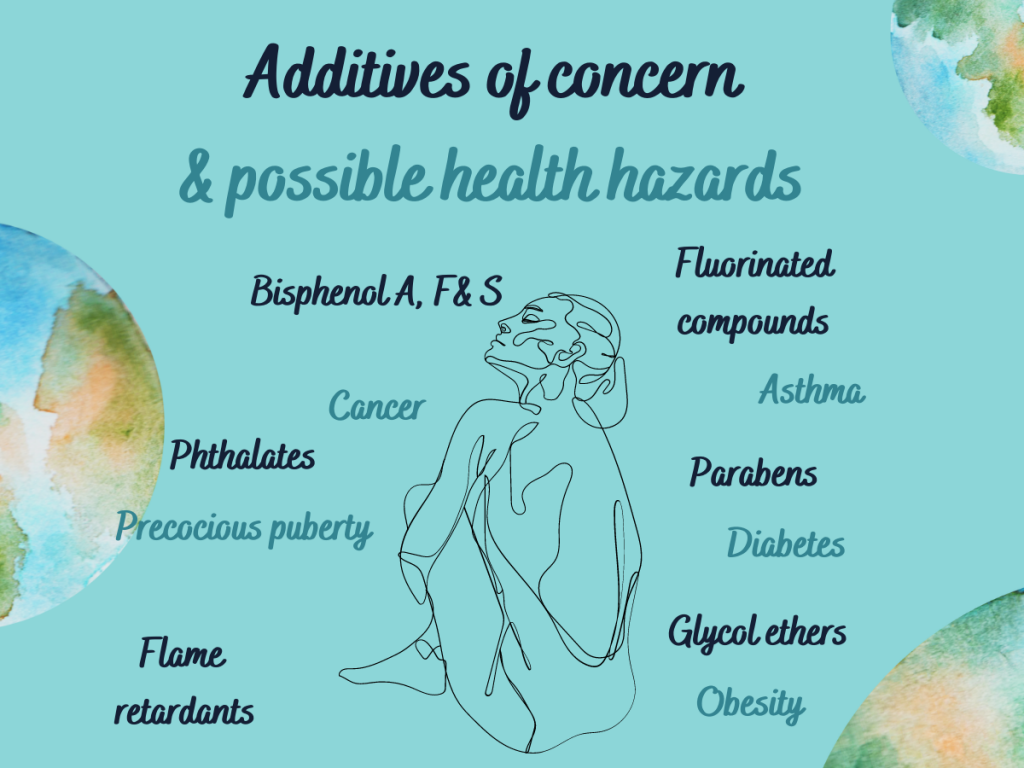

What can we do to make recycling more efficient?
Again, relying solely on others to solve this problem is unrealistic. The plastics industry is a big lobby, part of the petrol industry.
It’s up to us to be well informed and to separate the waste correctly.
10 tips to simplify plastic recycling:
- Remove the contents of the plastic packaging. No need to clean them with soap, but removing food scraps or rinsing makes them easily detectable by the sorting centres.
- For mixed packaging, separate the different layers of material components to make sure it doesn’t end up in the regular trash. For example, removing plastic from cartons, lids from glass bottles, etc.
- Remove the labels, especially if it is very large and comes off easily.
- Leave the screw cap on the bottle so that it does not get lost after compressing the packaging.
- Avoid products that have pump mechanisms. It is better to reuse those and buy refills.
- Prioritize materials that are easy to recycle, such as aluminum. If you have the choice for the same product in the store, and have both the bottle and can options, choose the latter (and above all, recycle it in the correct bin).
- If you buy a product with plastic packaging, avoid the most deleterious forms such as PP, PS or LDPE.
- Always carry a bottle with you, especially in summer, to stay hydrated and avoid consuming plastic, while saving money.
- Avoid buying opaque, intense or black colored plastics, and if this is unavoidable, upcycle them!
- Always carry a mini bag with you for unscheduled shopping. There are some so small that it won’t take up much space in your purse or even your jacket or coat pocket. Plastic bags are almost impossible to recycle!
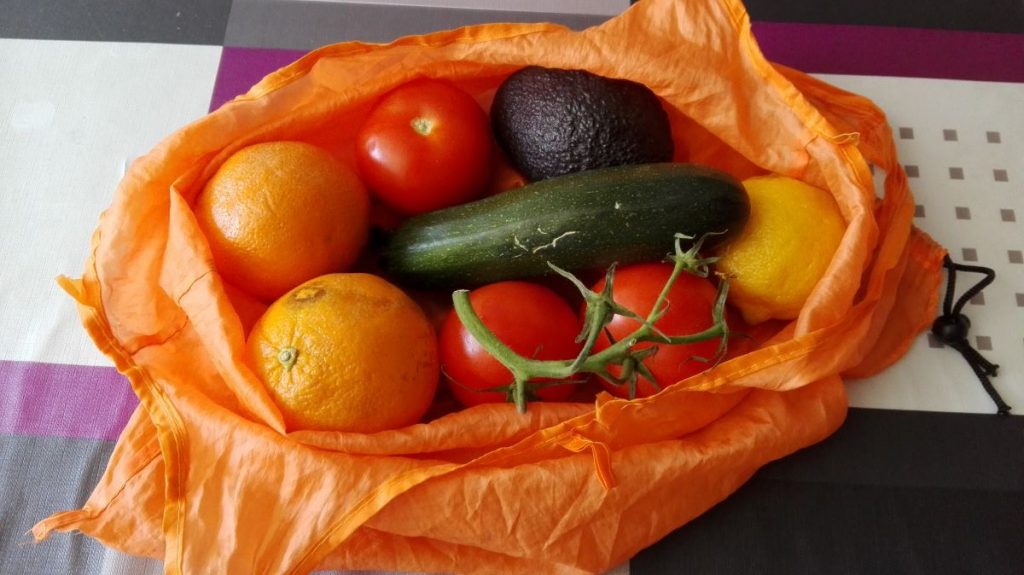

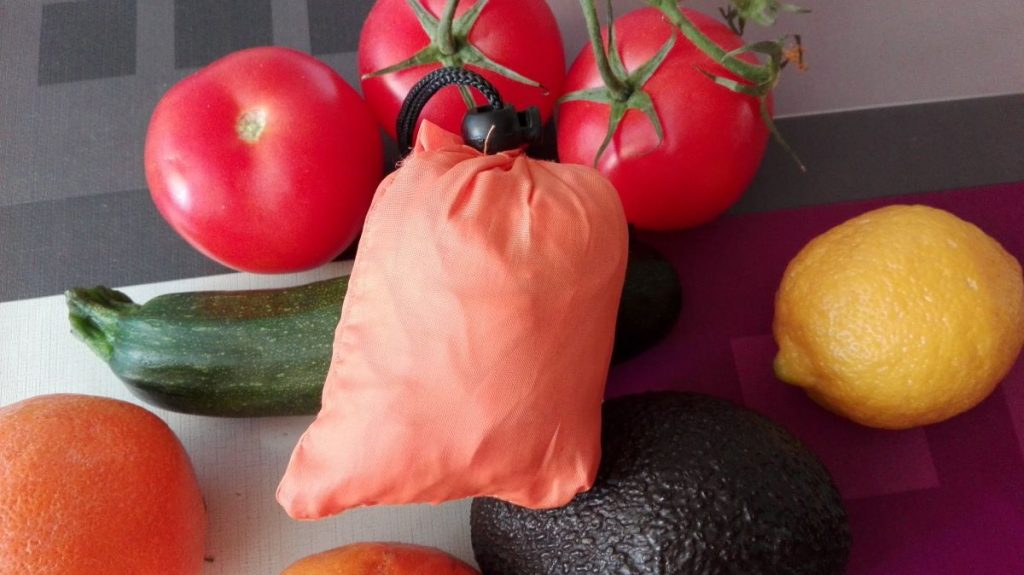

Go a step further: the zero-waste movement
This is of course a much more effective solution. Because the less plastic we consume, the less we will need to recycle!
Although it may sound complicated, it’s just a matter of habit that just requires a few adjustments and just a bit of organisation.
There are many shops that sell in bulk nowadays. Just fill your own containers, and you’re done!
Some people make their own products (such as laundry detergent) when they don’t have the luxury of having these kinds of stores near them. The recipes are much simpler than you might think.
We also have more and more solid solutions such as soaps or shampoos in bars, which are much more ecological than pump bottles or opaque plastic bottles.
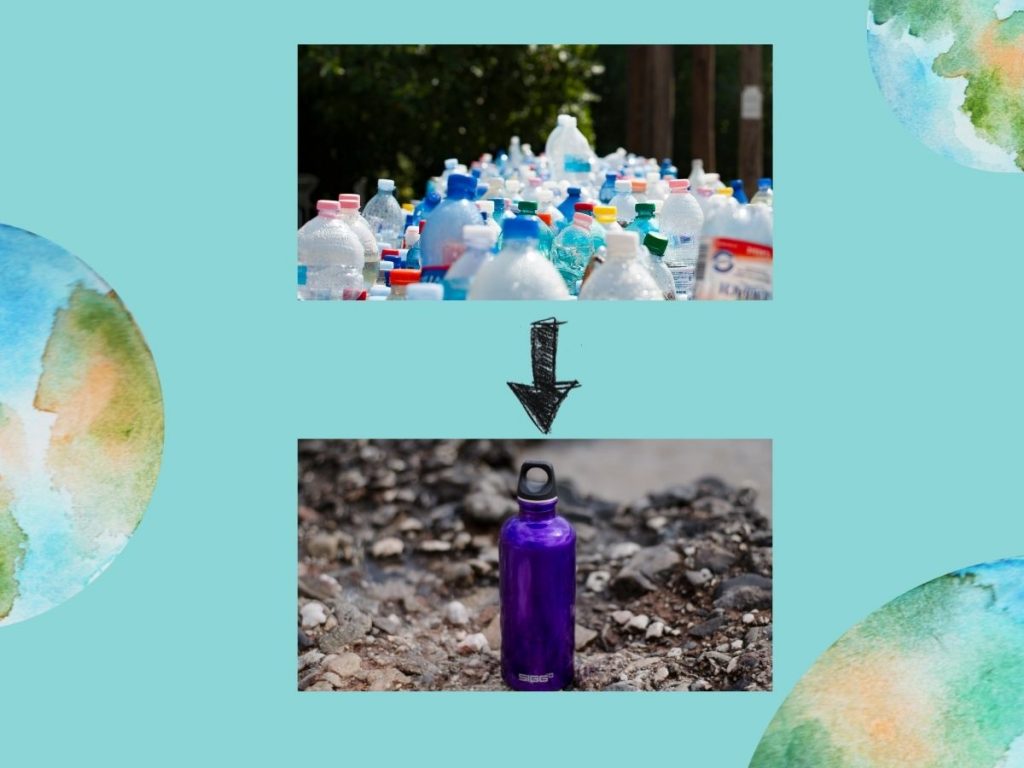

If you know of any stores that sell in bulk in your area or one you visited recently, please share it with our community through our little form. You will then be able to easily find them, wherever you go, thanks to our website.
If you liked this article, please share it around you. And if you have any other ideas that are not mentioned here, feel free to post a comment below.
If you would like to know more about the recycling process, we have interviewed Marc from the AMB (Barcelona Area in Spain) who is responsible to manage that part, on our YouTube channel. The interview is in Spanish but you can set the subtitles to automatically translate to English.
And remember: in the 3Rs, recycling is the last step. Before that, the priority is to Reduce, then Reuse.
Recycling is the last link in the chain and should never be the first!

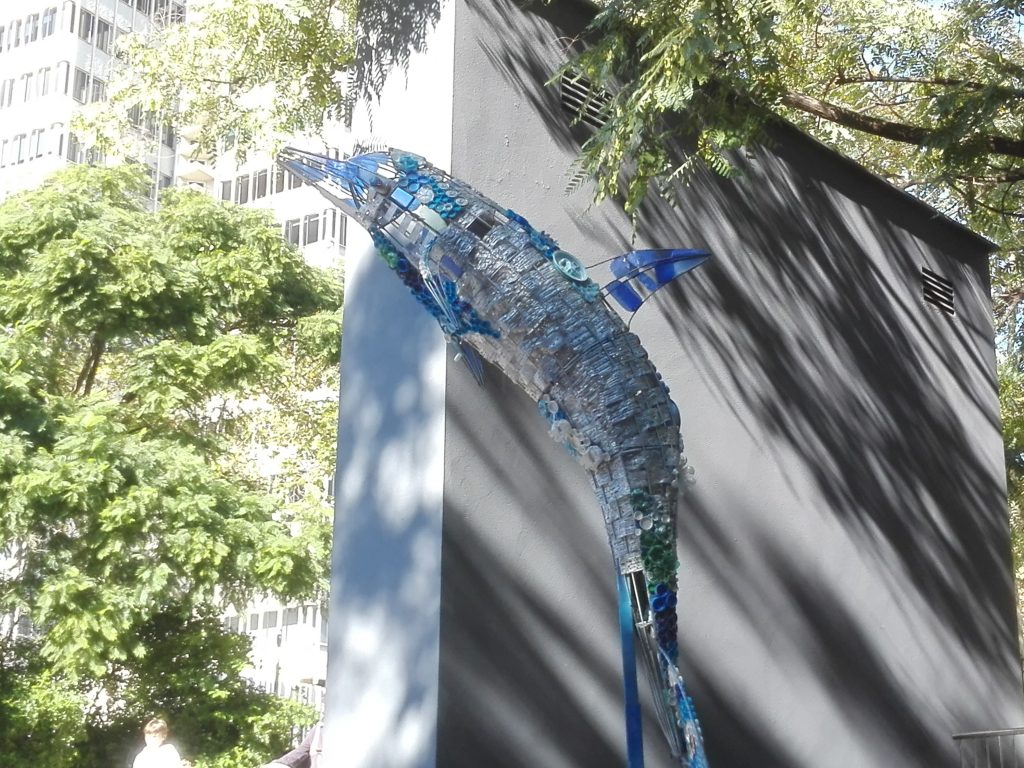
Pingback: How to choose the best sunscreen both for us and marine life - Planeta Sana®
Sur ce sujet, je vous propose une petite participation artistique à votre article par une série de dessins sur la pollution des océans intitulé “Panta rhei” réalisée à partir de photographies de particules de plastiques trouvées sur des plages aux quatre coins du monde !
Avec plaisir. Je viens de vous envoyer un email pour en discuter. Merci encore pour avoir lu notre article!